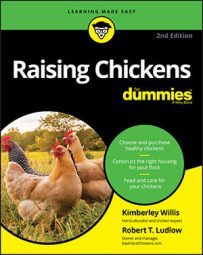Determining which breeds are rare is difficult because many poultry breeds are getting scarce. The genetics of many breeds need to be preserved because the genetic pool of chickens is becoming limited. Poultry breeds go through fads: For example, the current craze is for chickens that lay very dark brown eggs.
Welsummers, Marans, and Penedesencas were once very, very rare in the United States, but they’re rapidly gaining in numbers due to the dark brown egg craze.
Buckeye: The Buckeye is an American breed, developed by a woman in Ohio in the late 1800s. Buckeyes are a deep brown color, with some black in the tail. Although they bear some similarities to Rhode Island Reds, Buckeyes make better meat birds because of their deeper, broad-breasted bodies. Good foragers and winter hardy, they’re also good layers of brown eggs — perfect homestead chickens that deserve more attention.
Chantecler: The Chantecler was developed in Canada as a homestead chicken for meat and eggs. It comes in white and partridge colors. Chanteclers lay brown eggs, are good foragers, and mature quickly. They will brood eggs. They’re not particularly people-friendly birds.
Delaware: Delawares are layers of medium to dark brown, medium-size eggs. They were developed in the United States and are starting to make a comeback after almost fading away as a breed. They’re white, with some black ticking in the feathers of the neck and tail. They’re calm, they sometimes brood their eggs, and they make decent meat birds, too. They’re good layers for cold areas.
La Fleche: The La Fleche is known as the Devil Bird because its comb is shaped like a horn. La Fleches are good layers of large, creamy white eggs. They come in black, blue, white, and cuckoo colors. Fairly good as meat birds, they’re quick to mature. They’re now quite rare.
Faverolle: Faverolles are pretty and also efficient egg layers. Their eggs tend to be medium in size and creamy rather than pearl white. Faverelles come in two colors: white and salmon. (The salmon color is actually black and white with fawn, or salmon, wing and back areas.) The Faverolle has a “muff” of feathers around the ears, a beard, and lightly feathered feet with a fifth toe. Faverolles are calm and tame, good for home flocks, and will sometimes sit on eggs.
Penedesenca: Still fairly rare in the United States, Penedesencas were developed in Spain and are good layers of small, very dark brown eggs. The birds come in several colors and have an unusual comb shaped like a crown. They’re rather wild, they withstand heat well, and they’re good free-range birds.
Campine: The Campine is an old breed that originally came from Belgium. It has two color varieties, gold and silver. The gold has golden feathers marked with black bars, and the silver is gray-white with black bars. When the two colors are crossed, they produce chicks that can be sexed by color right after hatching.
Female chicks are a red-buff color, and males have a gray cap on their head. Campines were originally developed as a dual-purpose breed and are fairly good layers of white eggs. Both colors are rare now, with silver being the rarest.
White-Faced Black Spanish: This breed has been a little more popular recently and isn’t quite as hard to find as it once was. The breed originated in Spain, as the name suggests. These birds are tall and graceful, with glossy black feathers, large bright red combs, and large white earlobes, which contribute to their name.
As the birds mature, the rest of the facial area also becomes white. They lay white eggs. These birds are active and can be aggressive with other chickens.
Egyptian Fayoumis: The Egyptian Fayoumis are an old breed originating along the Nile River in the Middle East and brought to the U.S. this century to utilize their traits of quick maturity and resistance to disease. The birds are small, about 2 pounds in weight. Egyptian Fayoumis have slate-blue skin, silver neck feathers, and black-and-white barred body feathers. The birds are pretty good layers of small white eggs. They fly well, tend to be on the wild side, and are quite noisy.

